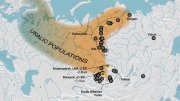Clifton Dawson has become a standout running back because of what he has done, but he has also excelled at not doing something: fumbling the football. In 721 career carries (and 798 touches, including pass receptions and kickoff returns), he has fumbled only five times. “I don’t know what it is with this guy,” joked head football coach Tim Murphy last fall, after Dawson committed a rare turnover in a Crimson win. “Every couple hundred carries, he fumbles the ball.”
 |
| Dawson demonstrates the "eagle claw" grip, a key to ball security. |
 |
| Carrying the ball high on the chest helps keep it away from grabby defenders. |
| Photographs by Jim Harrison |
It’s no accident. Like the rest of the Harvard offense, Dawson focuses on ball security. “Turnover ratio is the number-one factor in winning games,” he says. “If you get more turnovers than the other team, 95 percent of the time, you’ll win. You can run 80 yards and make a one-handed catch of a pass, but if you drop the ball, it doesn’t matter.”
On the sidelines, Dawson nearly always has a football in his hands; he is constantly renewing his feel for the pigskin. He hates wearing gloves and avoids them whenever possible. In a game, Dawson keeps the ball secure with five “pressure points” of contact—fingertips, palm, forearm, bicep, and chest. He also makes a point of using an “eagle claw” grip, holding the pointed tip of the football between his second and third fingers. “A lot of people put a finger on the tip of the ball,” he says. “But that’s a weak point of pressure.”
Dawson also carries the ball high against the upper chest. “You never want to carry the ball low, especially in traffic,” he explains. “That’s where a defender can grab at it.” Of course, ball security, like everything else, has its price. “From holding the ball so tightly,” he says, “someday I’m definitely going to have arthritis in my hands.”





